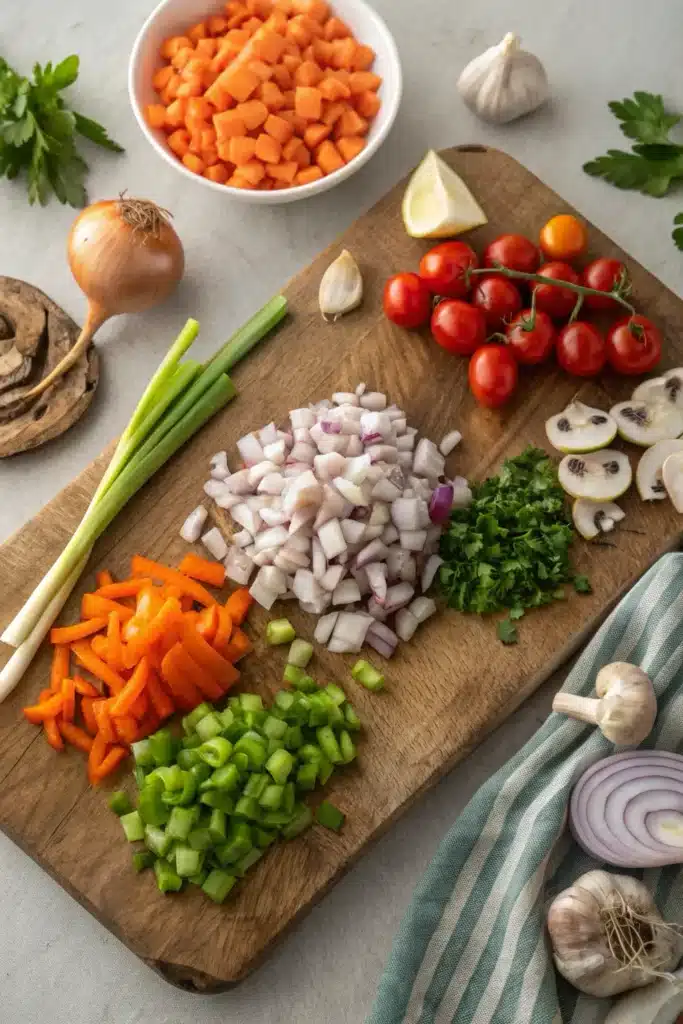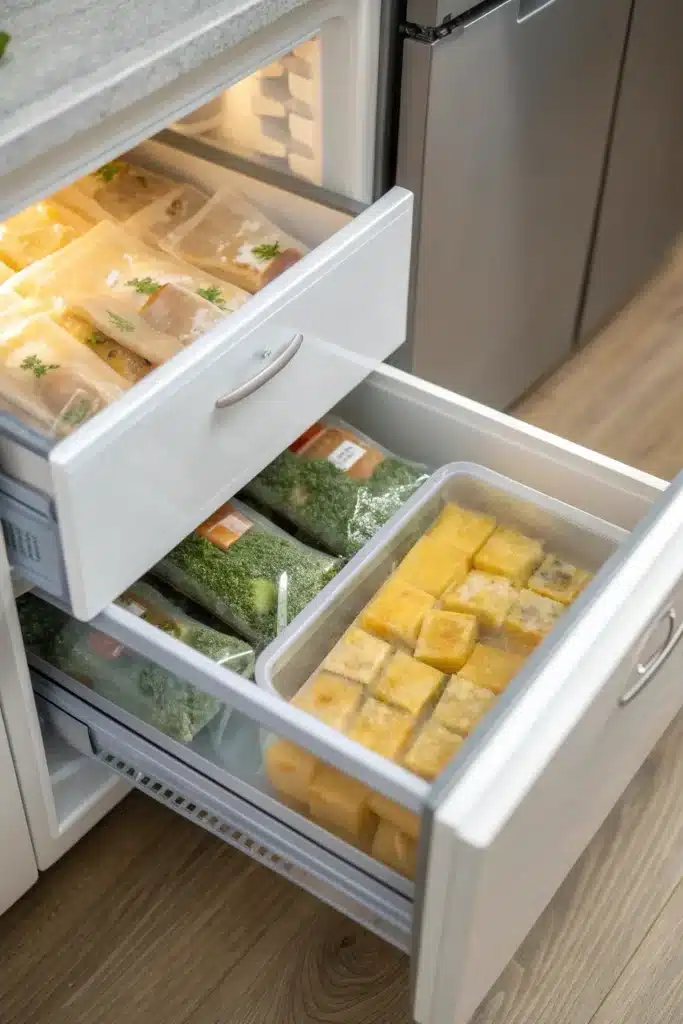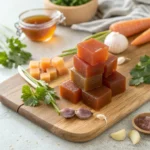If you’re tired of bland soups or over-salted store-bought stock, then homemade vegetable broth cubes are about to become your secret weapon. Packed with natural flavor, customizable, and free of preservatives, they’re the ultimate kitchen hack for boosting meals without the fuss. In this guide, you’ll learn how to make, store, and cook with homemade vegetable broth cubes that are healthy, flavorful, and super versatile.
Whether you’re trying to keep things plant-based, cut back on sodium, or just want a more robust flavor base for your meals, this article has you covered. We’ll walk through everything from the best ingredients to use, storage tips, and even dishes that will taste better with your cubes.
Looking for inspiration? Try this crowd-favorite dish that pairs beautifully with broth cubes: Crock Pot Mac And Cheese
Why Homemade Vegetable Broth Cubes Are a Kitchen Game-Changer
Benefits of Making Your Own Broth Cubes
Making your own vegetable broth cubes at home gives you full control over flavor and nutrition. Store-bought options are often loaded with sodium, preservatives, and artificial flavor enhancers. Homemade cubes, on the other hand, can be low-sodium, organic, and tailored to your taste preferences.
You’re also reducing waste by repurposing leftover veggies, peelings, and herbs that would otherwise be tossed. It’s a sustainable and budget-friendly choice that aligns with clean-eating habits.
How Store-Bought Versions Compare
Most commercial broth cubes come with ingredients like monosodium glutamate (MSG), hydrogenated oils, and high sodium content. They might deliver on convenience but fall short on quality. With homemade cubes, you eliminate those additives entirely.
Here’s a quick comparison:
| Feature | Store-Bought Cubes | Homemade Vegetable Broth Cubes |
|---|---|---|
| Sodium Content | High | Adjustable |
| Additives & Preservatives | Often included | None |
| Flavor Customization | Limited | Fully customizable |
| Dietary Restrictions | May contain allergens | 100% plant-based possible |
| Cost Over Time | Higher | Lower |
Don’t miss our Garlic Parmesan Chicken Pasta, which can be elevated with just one cube of your homemade broth.
Ingredients That Make the Best Homemade Vegetable Broth Cubes
Essential Vegetables for Deep Flavor
The secret to rich, savory homemade vegetable broth cubes lies in choosing the right vegetables. Stick with staple veggies that deliver a balance of sweetness, earthiness, and umami.

Must-have vegetables:
• Onions – Yellow or sweet onions form the backbone of your broth base.
• Carrots – Naturally sweet and perfect for balance.
• Celery – Adds depth and subtle bitterness.
• Garlic – A must for an aromatic punch.
• Tomatoes or tomato paste – For umami depth and color.
Optional but flavor-boosting additions:
• Mushrooms – Especially shiitake or cremini for umami and body.
• Parsnips – Peppery sweetness that complements carrots.
• Leeks or green onions – Mild, sweet onion notes.
• Bell peppers – Adds a touch of sweetness and a slight tang.
Vegetables to avoid (can cause bitterness):
Broccoli, Brussels sprouts, cauliflower, artichokes, or asparagus.
Tip: Roasting your veggies before simmering can deepen the flavor dramatically and give your broth cubes a richer tone.
Herbs and Aromatics to Include for Extra Richness
To elevate your vegetable broth cubes, add layers of flavor with fresh or dried herbs and aromatics.
Core flavor enhancers:
• Bay leaves – For that slow-simmered, comforting flavor.
• Thyme and parsley – Provide earthy and bright notes.
• Rosemary – Use sparingly for a deep, pine-like aroma.
• Peppercorns – Add warmth without making it spicy.
Creative additions for flavor profiles:
• Ginger or turmeric – Add color, zing, and anti-inflammatory benefits.
• Lemongrass or kaffir lime leaves – Perfect for Asian-inspired flavor cubes.
• Dried mushrooms or kombu – Boost umami, especially in vegan cubes.
Keep your herbs balanced—too much of one can overpower the entire blend. Also, avoid adding salt at this stage. It’s best to adjust seasoning when using the cube in recipes to suit each dish.
Don’t miss our Crock Pot Tortellini where a simple broth cube can turn store-bought tortellini into a comforting, gourmet bowl.
Step-by-Step Guide to Making Homemade Vegetable Broth Cubes
Prepping Your Vegetables and Herbs
Before anything hits the pot, prepping your ingredients correctly ensures maximum flavor extraction and the best cube consistency.

Steps to follow for preparation:
1. Wash all vegetables thoroughly – Especially if using skins or scraps to avoid dirt or pesticide residue.
2. Chop veggies uniformly – Smaller pieces cook faster and release flavor more evenly.
3. Use a balanced mix – Stick to a 2:1:1 ratio of onions, carrots, and celery as your base.
4. Add aromatics strategically – Tie herbs into a bundle with twine for easy removal after simmering.
5. Roast optional – For deeper flavor, roast your chopped vegetables at 400°F for 20–30 minutes before simmering.
Pro tip: Save scraps in a freezer bag throughout the week—onion skins, carrot peels, celery ends—and use them to make zero-waste broth cubes.
Cooking, Straining, and Reducing for the Perfect Base
This part transforms your prepped veggies and herbs into a rich, concentrated broth that will be frozen into cubes.
Cooking Process:
1. Add ingredients to a large stockpot – Fill with enough water to cover vegetables by 2 inches.
2. Bring to a boil – Then immediately reduce to a low simmer.
3. Simmer uncovered for 1.5 to 2 hours – The longer the simmer, the deeper the flavor.
4. Stir occasionally – Prevent sticking and help flavors mix evenly.
Straining and Reducing:
1. Strain through a fine mesh sieve – Discard solids or compost them.
2. Return liquid to pot and reduce – Simmer until it condenses into a thick, syrupy base—this intensifies flavor per cube.
3. Cool slightly – Let the concentrate rest at room temperature for about 10 minutes.
Final Step – Freeze into Cubes:
• Pour the cooled concentrate into silicone ice cube trays or molds.
• Freeze for at least 6–8 hours until solid.
• Transfer frozen cubes into airtight freezer bags or containers for long-term storage.
Each cube is roughly equal to 1 tablespoon of broth concentrate—just add water when using it in a recipe!
Discover great ideas like this delicious dinner starter: Philly Cheesesteak Pasta, where a single broth cube adds boldness and cohesion to the sauce.
Methods for Storing and Freezing Broth Cubes Safely
Best Practices for Freezing and Thawing
Once your homemade vegetable broth cubes are frozen, proper storage keeps them fresh and flavorful for months.

Here’s how to do it right:
• Use silicone ice cube trays – These make it easy to pop out individual cubes.
• Freeze until solid – Leave trays in the freezer for 6–8 hours minimum.
• Transfer to airtight containers – After freezing, store cubes in labeled, date-stamped freezer bags or BPA-free containers.
Each cube should be around 1 tablespoon, which is ideal for most recipes. You can always adjust by using more than one cube depending on how much liquid your dish calls for.
Thawing tips:
• Drop directly into hot liquids – Like soups, stews, or sauces—no need to pre-thaw.
• Microwave if needed quickly – Use low heat for 20–30 seconds to soften a cube.
• Refrigerate overnight – If planning ahead, place desired amount in a small dish in the fridge to slowly thaw.
Remember: Don’t refreeze thawed cubes. Only take out what you’ll use to preserve flavor and safety.
Tips for Storage Containers and Portion Sizes
Choosing the right containers ensures your vegetable broth cubes stay free from freezer burn and retain maximum flavor.
Top container options:
| Container Type | Pros | Cons |
|---|---|---|
| Silicone freezer trays | Easy release, reusable | Requires space while freezing |
| Ice cube trays + zip bags | Budget-friendly | Needs quick transfer to avoid odors |
| Vacuum-sealed bags | Longest shelf life | Requires special equipment |
| Glass containers with lids | Sustainable, non-toxic | Bulky for small freezers |
Pro tip: Label each bag with the type of broth cube (e.g., “Spicy Veggie Base” or “Classic Veg Broth”) and the date frozen. Most broth cubes stay fresh for up to 3 months, but can be used up to 6 months if stored airtight.
Don’t miss our article on Crock Pot Tortellini where just one or two broth cubes can elevate the whole dish from good to great.
FAQs About Homemade Vegetable Broth Cubes
Is a vegetable stock cube the same as vegetable broth?
No. Stock cubes are highly concentrated and often contain preservatives. Homemade vegetable broth cubes are made from real vegetables and herbs and frozen for convenience.
What not to put in vegetable broth?
Avoid cruciferous vegetables (like cabbage and broccoli), starchy veggies (like potatoes), and overly bitter greens.
Is it cheaper to make your own vegetable broth?
Yes. Especially if you use kitchen scraps, it’s far more cost-effective than buying store-bought stock or cubes.
What are the ingredients in vegetable stock cubes?
Store-bought cubes typically contain salt, flavor enhancers (like MSG), dehydrated vegetables, and preservatives. Homemade vegetable broth cubes are cleaner and healthier.
How to make your own veg stock cubes?
Simmer chopped vegetables with herbs, strain and reduce the liquid, then freeze into cubes for later use.
What are the 4 main ingredients for stock?
The classic base includes: onions, carrots, celery, and herbs (like parsley or bay leaves).
Recipes to Try with Your Homemade Vegetable Broth Cubes
Ready to put your cubes to good use? Try adding them to these delicious comfort food recipes:
• Garlic Parmesan Chicken Pasta
These are perfect dishes to enhance with a few homemade vegetable broth cubes. You’ll immediately notice the boost in flavor and aroma!
Final Thoughts
Homemade vegetable broth cubes are one of the simplest ways to level up your home cooking. They’re flavorful, easy to store, and a great use of ingredients you might otherwise throw away. Best of all, they let you control what goes into your food — no preservatives, no excess salt, just clean, rich, plant-based goodness.
Whether you’re simmering a hearty stew, cooking grains, or whipping up a one-pot pasta, homemade vegetable broth cubes make it easier to cook smarter and more deliciously.
Follow us on Facebook for new recipe drops and kitchen tips, or browse our boards on Pinterest for comfort food favorites and meal ideas.
Looking for more DIY kitchen hacks? Don’t miss our Garlic Parmesan Chicken Pasta where one cube transforms the sauce!
Table of Contents

Homemade Vegetable Broth Cubes
- Total Time: 2 hours 10 minutes
- Yield: 24 cubes 1x
- Diet: Vegan
Description
These homemade vegetable broth cubes are a healthy, freezer-friendly way to add instant flavor to your soups, stews, grains, and sauces. Made with fresh vegetables and herbs, they’re a cleaner, more flavorful alternative to store-bought stock cubes.
Ingredients
- 2 onions (chopped)
- 3 carrots (chopped)
- 2 celery stalks (chopped)
- 4 cloves garlic
- 1 tomato (or 2 tbsp tomato paste)
- 1/2 cup mushrooms (optional)
- Fresh herbs: thyme, parsley, bay leaf
- 8 cups water
Instructions
- Add all vegetables and herbs to a large pot.
- Cover with water and bring to a boil.
- Simmer uncovered for 1.5 to 2 hours.
- Strain solids and return broth to pot.
- Reduce to a thick concentrate.
- Cool slightly, pour into ice cube trays, and freeze.
- Store frozen cubes in labeled bags.
Notes
Use 1 cube per 1 cup water when cooking.
Keeps in freezer for up to 6 months.
- Prep Time: 10 minutes
- Cook Time: 2 hours
- Category: Homemade Staples
- Cuisine: Universal
Nutrition
- Serving Size: 1 cube
- Calories: 8 kcal
- Sugar: 0.5 g (natural)
- Sodium: 3 mg (approx.)
- Protein: 0.3 g
